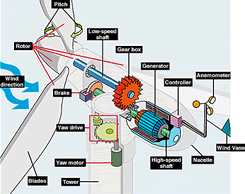How wind turbines work
Wind turbines use blades to collect the wind's kinetic energy. Wind flows over the blades creating lift (similar to the effect on airplane wings), which causes the blades to turn. The blades are connected to a drive shaft that turns an electric generator, which produces (generates) electricity.
Wind electricity generation has increased significantly
Wind electricity generation has grown significantly in the past 30 years. Advances in wind-energy technology have decreased the cost of wind electricity generation. Government requirements and financial incentives for renewable energy in the United States and in other countries have contributed to growth in wind power.
Total annual U.S. electricity generation from wind energy increased from about 6 billion kilowatthours (kWh) in 2000 to about 434 billion kWh in 2022. In 2022, wind turbines were the source of about 10.3% of total U.S. utility-scale electricity generation. Utility scale includes facilities with at least one megawatt (1,000 kilowatts) of electricity generation capacity.
Last updated: December 27, 2023, with data from the Electric Power Monthly, December 2023. Data are preliminary.

